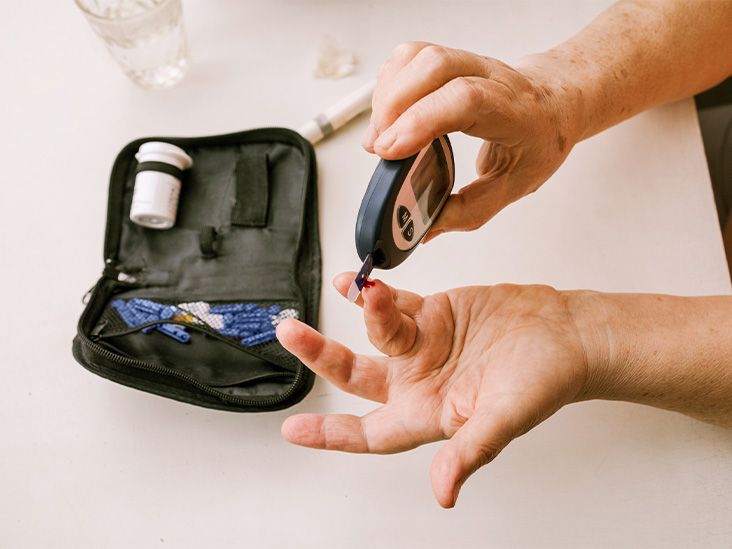Prediabetes, also known as borderline diabetes, is where a person’s blood sugar levels are higher than usual but not yet high enough for a diagnosis of type 2 diabetes.
Prediabetes is a condition that can progress to type 2 diabetes. Doctors may also refer to prediabetes as impaired glucose tolerance or impaired fasting glucose.
Research

Prediabetes
If symptoms do occur, they may include:
- unexplained weight changes
- increased appetite
- weakness
- fatigue
- blurry vision
- sweating
- recurring gum bleeding or skin infections
- slow wound healing
However, most people will not know they have prediabetes until they undergo testing.
According to the
Regularly consuming sugary drinks may also increase the risk. A 2021 review associates drinks with added sugar, including soda, juices, and sweetened tea or coffee, with a higher risk of diabetes.
Anyone with any of these risk factors may benefit from a prediabetes screening to check whether they have the condition.
A doctor may use the following blood tests to diagnose or screen for prediabetes:
- Glucose tolerance test: A glucose tolerance test measures how quickly the body can process the sugar in the blood in a 2-hour period.
- Fasting blood test: A fasting blood test measures blood sugar levels after a person has not eaten for a specific period.
- Hemoglobin A1C test: An A1C test measures the average blood sugar levels over 2 or 3 months. People do not need to fast or take any special liquids or medications for the A1C test, and it gives reliable results.
- Random plasma blood test: This measures a person’s blood sugar levels at any time.
The American Diabetes Association states that a doctor will diagnose prediabetes when test results show the following measurements:
- fasting blood sugar levels of 100 to 125 milligrams per deciliter (mg/dl)
- glucose tolerance levels of 140 to 200 mg/dl
- an A1C test result of 5.7% to 6.4%
A doctor may also re-test these levels to confirm that the readings are not due to one-off spikes in blood sugar.
Who should undergo screening for prediabetes?
Healthcare professionals may recommend that people start to undergo screening for prediabetes between the ages of
People with risk factors may need to start screening earlier and get follow-ups more often than this.
The Centers for Disease Control and Prevention (CDC) offers an
Anyone who is concerned they may have prediabetes should also visit a doctor for testing and a diagnosis.
Prediabetes is reversible. Lifestyle changes and weight management
Healthcare professionals may suggest a person work toward a goal of exercising for 30 minutes per day and switch to a low fat diet, with the aim of reducing their weight by 7%.
If someone has a high risk of type 2 diabetes or cannot make the necessary lifestyle changes, doctors may suggest management with medication. Medications may include metformin (Glucophage) and acarbose (Prandase).
Managing prediabetes may also involve continual monitoring of the risk factors and regular testing of blood sugar levels.
National Diabetes Prevention Program
The CDC leads a program called the
The program runs for a year and involves:
- a lifestyle coach keeping people motivated, helping them set and meet goals
- a CDC-approved curriculum with handouts, lessons, and more
- a support group of people with similar goals
The program may teach a person about the following:
- balanced eating
- physical activity
- managing stress
- getting back on track if new habits are difficult to maintain
- overcoming challenges, such as choosing healthy foods when eating out or during holidays
A lifestyle coach can work with people to make sure the sessions suit their needs, interests, and background.
The following actions
A healthcare professional may also recommend that people limit the amount of salt, added sugar, and carbohydrates in their diet.
Around
People may be able to prevent this progression if they make appropriate lifestyle changes. It is important for people with prediabetes to work with a healthcare professional to lower their risk of progression and complications.
What foods should someone with prediabetes eat?
Healthcare professionals may recommend that people with prediabetes eat a balanced diet with
People may also benefit from limiting simple carbs, salt, and added sugar.
What are the complications of prediabetes?
Even if it does not progress to type 2 diabetes, prediabetes
Can children have prediabetes?
In a
Parents and caregivers can help prevent diabetes in children by encouraging them to eat a balanced diet and engage in plenty of physical activity.
Can prediabetes progress to type 1 diabetes?
Prediabetes refers to a metabolic state that is a precursor to type 2 diabetes. It cannot evolve into type 1 diabetes.
However, there is
Learn about the differences between type 1 diabetes and type 2 diabetes.
How long does it take to reverse prediabetes?
With a well-balanced diet, regular exercise, and prescribed medical interventions, a person may be able to reverse prediabetes in about
Prediabetes is the stage before type 2 diabetes develops. It does not usually cause active symptoms, and most people will not be aware that they have the condition until it progresses to diabetes and starts causing health problems.
Anyone who is at risk of developing diabetes should have regular screening. Risk factors include high blood pressure, low levels of physical activity, and overweight or obesity.
Prediabetes can be reversible with a sustained exercise program and a balanced diet. People may also be able to join a diabetes prevention program.


